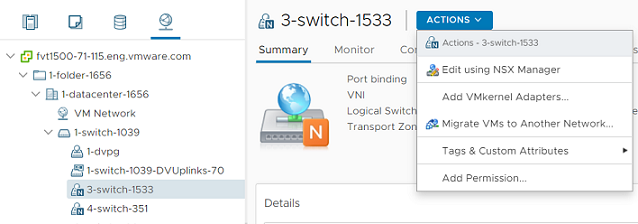A transport node prepared with VDS as a host switch ensures that segments created in NSX-T Data Center is realized as an NSX Distributed Virtual port group on a VDS switch and Segment in NSX-T Data Center .
In earlier versions of NSX-T Data Center, a segment created in NSX-T are represented as an opaque network in vCenter Server. When running NSX-T on a VDS switch, a segment is represented as an NSX Distributed Virtual Port Groups.
Any changes to the segments on the NSX-T network are synchronized in vCenter Server.
In vCenter Server, an NSX-T Data Center Distributed Virtual Port Group is represented as  .
.

Any NSX-T Data Center segment created in NSX-T Data Center is realized in vCenter Server as an NSX-T Data Center object. A vCenter Server displays the following details related to NSX-T segments:
-
NSX Manager
-
Virtual network identifier of the segment
-
Transport zone
-
Attached virtual machines
The port binding for the segment is by default set to Ephemeral. Switching parameters for the switch that are set in NSX-T cannot be edited in vCenter Server and conversely.
- Add VMkernel Adapters.
- Migrate VMs to Another Network.
- Replication Mode for the segment
- VLAN trunk ID used by the segment
- Switching Profiles (for example, Port Mirroring)
- Ports created on the segment
For details on configuring a vSphere Distributed Virtual port group, refer to the vSphere Networking Guide.